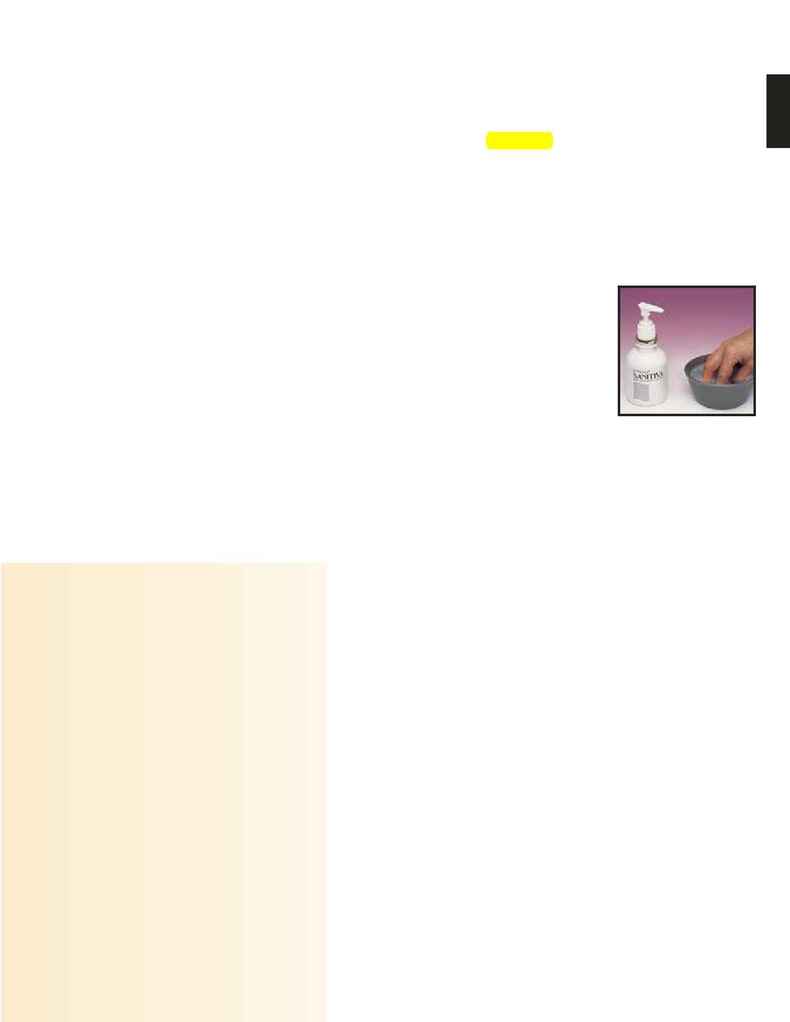
Sanitation
Sanitation is a term that means to remove dirt to aid in preventing the growth of microbes.
Sanitation is the first level of infection control. It is important to note that
sanitation methods
clean and reduce microbes on the surface, but do not kill microbes.
Two ways to describe
that to you would be first, to ask you to think of cleaning your house or apartment. If you are
dusting an end table, you are removing dirt that has gathered on the surface, but you are not killing
bacteria or germs that are possibly lurking there. Even if you used a furniture spray, you would
not be killing the bacteria. Unless you use a product with an efficacy label stating it has the
ability to kill specific microbes, the microbes would remain on the surface. Only the dirt or dust
would be removed.
The second example involves giving a pedicure, manicure or other skin care pro-
cedure. Prior to any of these procedures, apply an antiseptic to clean the skin.
An antiseptic is a product that can be applied to the skin to reduce
microbes.
In other words, you have a clean surface on which to perform pro-
cedures and you have helped to prevent the future growth of microbes. You may
also use an antibacterial liquid soap as a manicure or pedicure soak to further
reduce microbes on your client's skin before you begin your service. Remember, some of that bac-
teria might be good (nonpathogenic) and some may be harmful (pathogenic). Because you will not
be breaking the skin, it is not necessary to use a product stronger than an antiseptic.
The Basics of Hand Washing
1. Moisten hands with warm water and antimicro-
bial, also called antibacterial, liquid soap.
2. Spend at least 15-20 seconds working up a good
lather. Pay particular attention to the fingers and
the spaces between them and the fingernails.
3. Rinse hands well in warm water. Position hands
and fingertips downward so the rinse progresses
from wrist to fingertips.
4. Dry hands well to remove any remaining micro-
organisms. A single-use paper towel or hands-
free air blowers are the most effective and do not
carry the risk of cross-contamination posed by
communal cloth towels.
Infection control practices for sanitation of the school or
salon require shared responsibilities from everyone on
the team in order to provide a healthy environment.
Review the Infection Control Sanitation Guidelines chart
to gain knowledge in the steps taken to prevent the
53
2
SALON ECOLOGY
SANITATION GUIDELINES
1. Provide well-lit work areas.
2. Provide hot and cold running water.
3. Sanitize shampoo bowls before and
after each use.
4. Clean and remove hair and debris
from all implements before
disinfecting.
5. Wash your hands with liquid soap
and water immediately before serv-
ing each client. Antibacterial liquid
soap is recommended since bar
soaps can harbor and transmit
microbes.
6. Remove all hair clippings after each
service to prevent accumulation.
